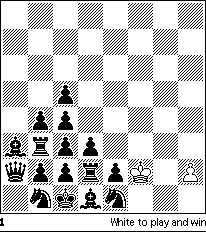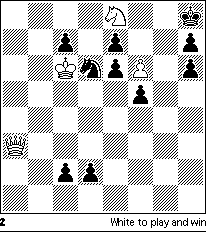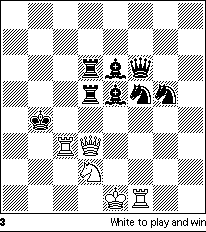
Endgame Explorations 8: White Minimals
Noam Elkies
While the composed endgame usually aims for an artistic effect by distilling a tactical idea to a very concentrated and polished form, some endgames emphasize humor, usually by purposely exaggerating one idea to a ridiculous extreme. In the Korolkov study concluding Part 7, this was done by an audacious proliferation of White knights. Here we will observe another extreme, one of mind (or rather tactics) over matter: White wins with only one man besides the king against an army of Black pieces. Consider for example the following monstrosity by Gorgiev:

We can hardly complain about the economy of White force, but all sixteen of Black's pieces are on the board! Of course, after 1 Kxe1 Black can only shuttle the queen between a1 and a2, but White must still find a way to break through the Black tortoise-shell. If White promotes the h-pawn to a queen he can pick up the pawns on c5 and c4 and then the Rb3, but no more; indeed White should leave Rb3 alone, for 10 Qxb3? opens Pandora's box: 10 ... Qa2 11 Qa2 b3 12 Qxb3 Bd6 13 Qg8 (else 13 ... Bg3+) 13 ... Na3 and the long-trapped Black army comes to life and soon overwhelms White. Thus White must promote a knight so that an eventual Nxb3 is checkmate. But that will only be possible if the Black queen is on a1 when White is ready for Nxb3, that is, if the Black queen is on a2 when White plays h8/N (else it will always move to a square of color opposite to the knight's, and so will be on a2 when the knight is on a5, c5 or d4). This explains the solution:
1 Kxe1 Qa1 2 h3! Qa2 3 h4 Qa1 4 h5 Qa2 5 h6 Qa1 6 h7 Qa2 7 h8/N! Qa1 8 Nf7 Qa2 9 Nd6 Qa1 10 Nb7! Qa2 11 Nxc5!
If White had taken the c4 pawn with 10 Nxc4? Qa2 11 Na5, then Black can save himself by losing a move with 11 ... c4!
11 ... Qa1 12 Nb7 Qa2 13 Na5 Qa1 14 Nxc4 Qa2 15 Na5 Qa1 16 Nxb3#
That study, while amusing and at times subtle (2 h3!, 6 h8/N!, 11 Nxc5!), looks rather unnatural and schematic with the Black pieces already jammed helpless in the corner and the great disparity of force apparent in the initial position. For a more natural-looking setting and a more surprising rendition of the same theme we turn to the following study (Korolkov 1956):

Here White is ahead a queen for a bunch of pawns---two of which, however, are on the verge of promotion. Thus White throws everything at the Black king:
1 Qg3! Nxe8
After 1 ... c1/Q+ 2 Kd7 Nxe8 White has also the option of winning
prosaically with 3 Kxe8 exf6 (or 3 ... Qc6+) 4 Kf7.
2 Qg7+!! Nxg7 3 f7
And after 3 ... c1/Q+ 4 Kd7 d1/Q 5 Kc8, Black has gone up three queens and a knight in the space of four moves, but is defenseless against White's remaining pawn!
And finally a recent humorous twist on Ye Olde Smothered Mate:

This study was created jointly by Comay, Einat and Friedgood at a 1988 chess composers' conference in Budapest in response to a challenge to produce within a few days an original endgame study without pawns (this pawnless proviso is sometimes known as the "aristocratic theme"). Of the eight studies submitted, this one was ranked equal third. Note that without pawns and with the usual taboo against promoted pieces in the initial position this endgame, like Gorgiev's (Diag.1), uses the maximum available Black force. White has the initiative, but must take care not to let Black shelter his king and exploit his three-piece advantage (e.g. 1 Qc4+? Ka5 2 Ra3+ Kb6 and White must take the perpetual with Rb3+ because 3 Qa6+? loses to Kc7). Thus:
1 Qb1+! Kxc3
If 1 ... Ka4 2 Ra3+! Kxa3 3 Qb3#.
2 Qb3+ Kd4 3 Rf4+!!
3 Qc4+ Ke3 forces White to repeat moves with 4 Qe2+ Kd4.
3 ... Bxf4 4 Qc4+ Ke5
Now that f1 is vacated, 4 ... Ke3 would be met by 5 Nf1+ Kf3 6 Qe2#.
5 Qe4+!! Nxe4 6 Nf3#
The king is uniquely smothered in mid-board by his seven officers!
Noam Elkies is now Professor of Mathematics at Harvard University and is the author of "Chess Art in the Computer Age," published in ACJ 2 (1993). This article originally appeared in Chess Horizons.Next column: Grigoriev.
This page last modified on
28 April 2018.
Copyright (c) 1995-2018 Christopher F. Chabris. All rights
reserved.



